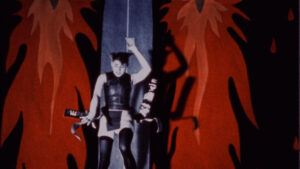One festival, many different gauges

We know that very well: at Il Cinema Ritrovato festival watching the programmed films is the occasion to discover a great variety of rare screening formats and technologies, that make the experience of the theatre even more magical and astonishing. It is not by chance that every year the festival dedicates a section to the films that are presented in less classical formats, a section that this year will allow us to rediscover, among other things, the 9.5 mm Pathé Baby format.
 This year we have divided this strand into two parts. In the first we head to Germany to present a very unusual film archive located in the University of Paderborn. It was established by Annette Brauerhoch in the early 2000s and devotes itself exclusively to the work of female experimental filmmakers from German-speaking countries. We are presenting a selection of 16mm prints dating from the 1960s until the 2000s. The three programmes will afford the opportunity to discover German underground and experimental films that in some cases sailed under the radar outside their country of production. Filmmakers such as Ute Aurand, Christine Noll Brinckmann, Elfi Mikesch, Pola Reuth and many others fought against the conservative and reactionary imagery in conventional film production. Their mission was to attack the stereotypical presentation of gender roles in mainstream cinema and to broaden the established view of female sexuality and aesthetics.
This year we have divided this strand into two parts. In the first we head to Germany to present a very unusual film archive located in the University of Paderborn. It was established by Annette Brauerhoch in the early 2000s and devotes itself exclusively to the work of female experimental filmmakers from German-speaking countries. We are presenting a selection of 16mm prints dating from the 1960s until the 2000s. The three programmes will afford the opportunity to discover German underground and experimental films that in some cases sailed under the radar outside their country of production. Filmmakers such as Ute Aurand, Christine Noll Brinckmann, Elfi Mikesch, Pola Reuth and many others fought against the conservative and reactionary imagery in conventional film production. Their mission was to attack the stereotypical presentation of gender roles in mainstream cinema and to broaden the established view of female sexuality and aesthetics.
A nother offering this year is directly connected to these developments. It is the presentation of a restoration project carried out by the Kinothek Asta Nielsen in Frankfurt am Main and lead by its former managing director Karola Gramann. The queer punk Austrian underground feature Rote Ohren fetzen durch Asche (Flaming Ears) was directed by Ursula Pürrer, Dietmar Schipek and Ashley Hans Scheirl (she/he will represent Austria together with Jakob Lena Knebl at the Venice Biennale this year) on Super8 back in 1991. Thanks to the Kinothek Asta Nielsen it is now ready for the big screen again after a long and elaborate digital restoration work.
nother offering this year is directly connected to these developments. It is the presentation of a restoration project carried out by the Kinothek Asta Nielsen in Frankfurt am Main and lead by its former managing director Karola Gramann. The queer punk Austrian underground feature Rote Ohren fetzen durch Asche (Flaming Ears) was directed by Ursula Pürrer, Dietmar Schipek and Ashley Hans Scheirl (she/he will represent Austria together with Jakob Lena Knebl at the Venice Biennale this year) on Super8 back in 1991. Thanks to the Kinothek Asta Nielsen it is now ready for the big screen again after a long and elaborate digital restoration work.
In the second part we celebrate the 100-year anniversary of the 9.5mm format. In 1922 Charles Pathé presented the iconic home movie system Pathé-Baby. The 9.5mm film was the most compact film format at that time and was used to distribute commercially made films. Later a camera was also introduced. At the festival we will present four sessions with home versions of significant films distributed on 9.5mm via the Pathéscope film catalogue.

Lichtspiel / Kinemathek Bern will present two programmes compiled of vintage prints projected with a special 9.5mm projector. Two other programmes will be presented digitally by the Fondation Jérôme Seydoux-Pathé and INEDITS, who will also curate three short compilations of 9.5mm amateur films, which will allow us to travel through Italy and visit the Bologna of the past. Thus, we can all enjoy some of the highlights of the 9.5mm collections from European film archives.
The experience of cinema in unusual formats doesn’t belong only to the dedicated section, but invades other areas of the festival. For instance, the magical screening with the carbon lantern return in Piazzetta Pasolini. Here, we will be able to watch the first cinematic documentary, Nanook of the North, the beatiful images of Sardinia in Cainà ovvero l’isola e il continente with Maria Jacobini (presented in combination with a surprising advertsing film of the Twenties) and a selection with the best of 1902 that will include, of course, the Voyage dans la Lune by Méliès.











